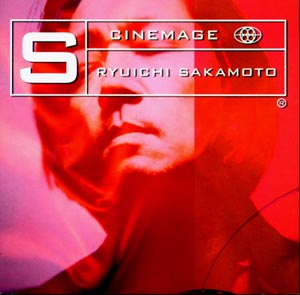![[Metroactive Music]](http://metroactive.com/music/gifs/music468.gif)
[ Music Index | San Jose | Metroactive Central | Archives ]
Hack or Pop Genius?
Getting squishy with the legend, Ryuichi Sakamoto
By Suzanne Ramsey
Ryuichi Sakamoto's two new Sony Classical releases, Cinemage and BTTB, leave me undecided if he's a musical hackmeister clichéologist (like Sir Andrew Lloyd Puccini) or a pop-musical genius. He has made a career out of emulating innumerable musical styles, from Kraftwerkian synth-pop to majestic award-winning epic film scores à la Herrmann. With so many questionable cheeses in his musical fondue, Sakamoto is a hard nut to crack.
Cinemage is a collection of the musician's most famous movie themes, recorded live with a 70-piece orchestra (Sakamoto conducts and plays piano). It opens with a sumptuous version of the career-boosting theme to Nagisa Oshima's Merry Christmas, Mr. Lawrence, "Forbidden Colours." I still have my original 7-inch picture disc of this 1983 song, recorded after David Sylvian (words, vocals) and Sakamoto (music) left their respective post-glam synth-pop bands (Japan and YMO). The new recording is supreme bliss. Sylvian's rich, heartfelt vocals set against the faint Japanese folk melody of dancing parallel fourths, played intoxicatingly by Sakamoto, makes my panties squishier than a piece of oversteamed dim sum.
Sakamoto won an Oscar and a Grammy for his score of Bertolucci's tragic Chinese epic The Last Emperor. It's a lofty and pompous aural landscape, filled with pleasing neo-romantic lyrical lines. It makes me want to climb up a mountain, twirl around like Stevie Nicks, rip open my bodice and scream, "THE HILLS ARE ALIVE!" The score packs a meatier wallop than any Celine Dion chest-thumpin' theme. At one point, Sakamoto's exaggerated chord progressions awaken the ghost of a caped Liberace flying though the orchestra pit, finally settling at the piano to play his kitschy dancing-waters routine in a gold-studded lotus blossom kimono.
The score to Little Buddha is a guilty indulgence. My K-Tel classical music education tells me I've heard that theme before. I scratch my bum in wonderment as Samuel Barber's mournful "Adagio for Strings" is lifted and wonderfully exploited. Do I also hear foggy strains of Debussy's "Reverie" and Ravel's "Pavane for a Dead Princess" in the theme to Wuthering Heights? The gratifying, sensual musical contours yank on my heartstrings and inspire the bearskin-rug-fire scenario--with me lapping gooey 7-Eleven nacho cheese sauce and jalapeño peppers off a lover's heaving chest.
Sakamoto's theme to the opening of the 1992 Olympic Games in Barcelona, "El Mar Mediterrani," is an unfocused hodgepodge of nonsensical marching-band fanfare fluff, and even features DJ Spooky. It was recorded live in Japan on a 1997 tour. This stylistically schizophrenic piece is difficult to listen to as it evokes the horror of my ill-fitting pubescent marching-band uniform. I asked DJ Spooky at the Other Minds festival how he felt about being on Sakamoto's new cinematic album. He didn't even know about it! Smile, Mr. Genre Crasher, you're on Sony Classical!
Sakamoto's other new release, BTTB (Back to the Basic), features solo works for the piano and was a huge cross-generational hit in Japan. And it started the positive "healing music trend." When I was in Tokyo in November, shopping malls displayed player pianos churning out the mega hit "Energy Flow," which was originally composed for a nutritional-tonic ad campaign for TV. BTTB showcases Sakamoto's agile ability to write pleasing, syrupy romantic melodic lines that are chock-full of nutritious Satie, fortifying Ravel, wholesome Brahms, and bone-building John Cage. Sakamoto seems to remember the 1980s ad for Geritol that was set to the healthful strains of Satie's First Gymnopédie.
On March 18, Sakamoto performed at San Francisco's Fillmore in support of BTTB. The sold-out show started out with some hypnotic DJ spinning by the maestro himself, as the guys sitting next to me assumed the lotus position in their folding chairs. I was very pleased when Sakamoto's bum hit the piano bench. The enthusiastic crowd was still partially meditating as he graciously played palatable Satie-flavored sinuous pieces like "Opus" and "Chanson."
One of the highlights of the evening was Sakamoto's experiments with the John Cage-inspired prepared-piano technique. The second piano on stage had an exotic, dampened gamelan sound that was achieved by inserting erasers and pingpong balls between the strings. The crowd giggled when one of the pingpong balls scampered away, stagehand in tow. Sakamoto's playful nature was showcased on "Tong Poo," arranged for one piano and four hands. Sakamoto inserted a floppy disc into his tinny-sounding Yamaha grand and, well, played with himself.
Sakamoto is not subtle about his influences. I swear I heard a little "Nadia's Theme" and a hybrid of "Rainy Days and Mondays"/"I Can't Help Falling in Love With You." My companion likened Sakamoto to an intermediary for Famous Dead Composers, channeling their beloved lyrical melodies into a satisfying casino-styled salad bar with canned fruit-cocktail bits in fluffy Cool Whip. YUM! I'll be back for a second heapin' helpin'.
Yanni?
Sakamoto?
SAKAMOTO!!!!!!!!!!!!!!!!!!!!!!!!
[ San Jose | Metroactive Central | Archives ]
Copyright © 2000 Metro Publishing Inc. Metroactive is affiliated with the Boulevards Network.
For more information about the San Jose/Silicon Valley area, visit sanjose.com.
![]()

From the April 13-19, 2000 issue of Metro, Silicon Valley's Weekly Newspaper.